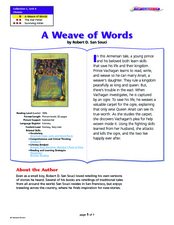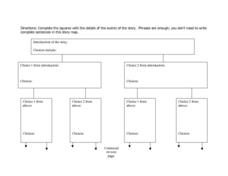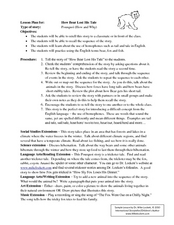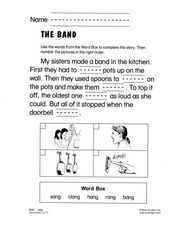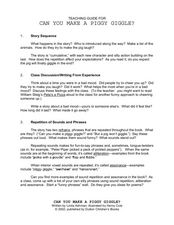Curated OER
A Weave of Woods
Focus on vocabulary, comprehension, and analysis while reading A Weave of Woods, a colorful picture book by Robert D. San Souci. Young learners use worksheets to preview, predict, practice paraphrasing, and make comparisons. The richly...
Curated OER
The Jacket: Journal Templates Teacher's Guide
Explore this story involving prejudice and racism to enhance learners' comprehension skills. The story The Jacket by Andrew Clements involves an African American boy who is falsely accused of stealing someone's jacket. This teacher's...
Pearson
Reading Comprehension Sequence Chain
Follow any story and record each step on the graphic organizer provided here. There are lines to record the title, author, and illustrator, boxes where pupils can fill in character and setting, and six boxes in which learners can note...
Curated OER
What is a Philanthropist?
What does a philanthropist do? Help your class explore philanthropy using character development and literacy ideas. Learners will define and give examples of philanthropy, listen to The Lion and the Mouse, discuss how the characters help...
Curated OER
Goldilocks and the Three Bears
Explore storyboards with your pre-reader using the familiar story "Goldilocks and the Three Bears." They look at pictures as you read the captions in a comic book style. At the end, they try to finish the story based on a resolution...
Curated OER
Listening Comprehension: Retell Main Events of a Story
Story retell is a very important skill. Little learners use a story map and a previously heard story to walk through the retell and story sequencing process. They complete this activity as a whole class and then on their own.
Curated OER
My Grandpa
In this sequencing parts of a story instructional activity, learners read a short story, observe pictures, and number the pictures in the correct order. Students write 6 answers.
Curated OER
Pumpkin Time
Students visit a pumpkin farm and discuss the characteristics of a pumpkin and how they grow. They create a class story about the trip to the farm with each student supplying a sequence for the story.
Polk Bros Foundation
I Can Sequence Important Events
After reading any short informational or fictional text, ask your class to analyze the important events. They note down three important events on a short timeline, describing the events with either words or drawings. After this, pupils...
This Reading Mama
Chain of Events
Ask your class to demonstrate their understanding of sequence. The graphic organizer provides five boxes for events and a few prompts to get kids started. Arrows point from one box to the next, demonstrating the progression of one item...
Curated OER
Events From a Story Graphic Organizer
Here is a well-designed graphic organizer which should help your readers organize the sequence of events from any story they read. The organizer should help any pupil who is trying to piece together events from a story for a book report.
Curated OER
How Bear Lost His Tale: Storytelling
In this storytelling lesson, children practice re-telling the story of "How Bear Lost His Tale", review and write out the story sequence, and learn about homophones like tail/tale, sail/sale, etc. Extension activities for various content...
Curated OER
Sequencing Life Cycles and Daily Activities
First graders sequence story situations. In this sequencing lesson, 1st graders read Charlie the Caterpillar and sequence his life cycle. Students role play the story parts and sing a song about metamorphosis.
Curated OER
The Band
In this identifying words spelled with "-ang" activity, students use the word bank to fill in the blanks with -ang words and then number the pictures in order. Students write 9 answers.
Curated OER
THE LITTLE RED HEN - A TALE OF COOPERATION
Students explore how much pleasure reading can bring, explain the concept of "story sequence", "re-tell" a story through art, and read other folktales.
Curated OER
Which Way???
In this story sequence worksheet, learners read a few paragraphs about a genie who granted wishes to a boy. Have your class number six story events to show the correct sequence. Kids can also learn the lesson "be careful what you wish for!"
Curated OER
Teaching Guide: Can You Make a Piggy Giggle?
Students explore the book Can You Make a Piggy Giggle?. In this language arts lesson, students focus on a variety of aspects within the book. Students study the illustrations, listen for rhymes, and attempt the tongue twisters in the text.
Curated OER
Mr. Granger Exercises: Order of Events
For this story sequence worksheet, students read a passage about a man who begins an exercise regimen. Students place 8 events in the correct sequence by using the numbers 1-8.
Curated OER
Sequence Maker
In this story sequence worksheet, students read five sentences about getting up in the morning that are out of order. Students number them in the correct order and then write a paragraph using the sentences.
Curated OER
Story Sequence: Chrysanthemum
In this story sequence worksheet, students write the events in the beginning, middle and end of the book Chrysanthemum by Kevin Henkes. There are three boxes to list or draw events.
Curated OER
Eensy Weensy Spider Lesson Plan
Students create their own versions of The Eensy-Weensy Spider. In this creative writing instructional activity, students read The Eensy-Weensy Spider and imagine what else the spider could do. Students then draw a picture depicting the...
Curated OER
Sort the Story- Roy the Zebra
For this story sequence worksheet, students cut out 6 picture cards that depict a zebra in action. Students assemble the cards in the correct sequence to tell the story, then draw what they think will happen next.
Starfall
The Dog and His Bone
After reviewing a comic of a dog and his bone, students draw their own pictures on the top and write what they think happens next in the story. This activity is a good transition into longer story writing, as well as a good practice in...
Curated OER
Story Boards
Students devise story boards to sequence the main events in a story. They draw a picture that demonstrates the main event in each chapter of a story and label it with a sentence.


